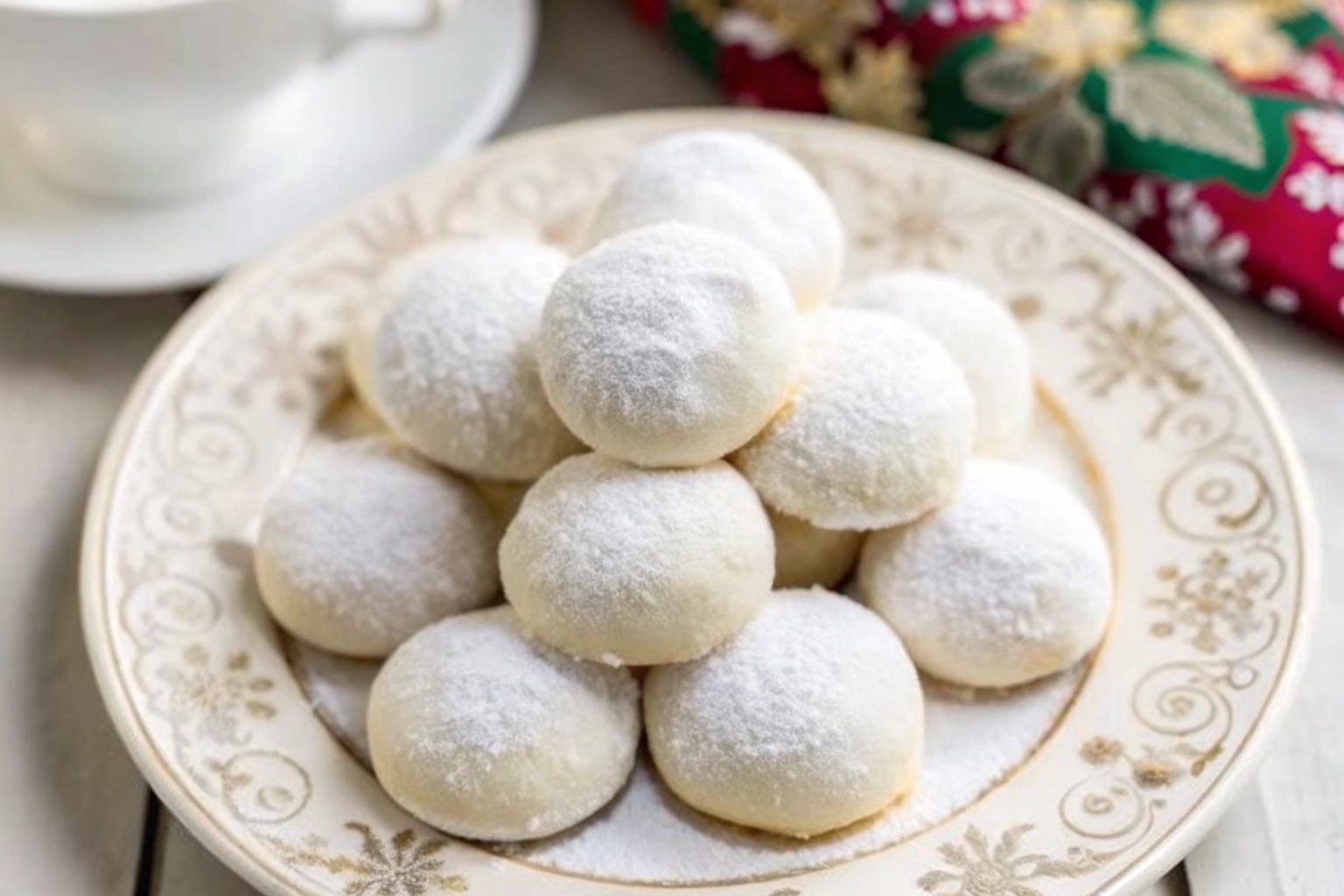What Are Italian Wedding Cookies?
Italian Wedding Cookies, also known as snowball cookies, butterball cookies, or sometimes even Russian tea cakes, are delicate, buttery treats that melt in your mouth with every bite. Traditionally associated with Italian celebrations, these cookies are rolled in powdered sugar, giving them a snowy, festive appearance. Their hallmark is their tender texture and nutty flavor, making them a favorite for weddings, holidays, and special occasions. These cookies often evoke a sense of nostalgia, as they’re deeply tied to family traditions and festive gatherings. Their simple ingredients and timeless appeal make them a staple in many households, not just in Italy but around the world. Whether enjoyed as part of a holiday dessert platter or as an afternoon treat with tea, Italian Wedding Cookies never fail to delight.
Why Are They Called Wedding Cookies?
The name “Wedding Cookies” likely stems from their historical use in wedding celebrations. Across cultures, including Italian, Mexican, and Russian traditions, these cookies symbolize unity and celebration. In Italian weddings, these cookies might have been served as a gesture of good fortune and sweetness for the newlyweds’ journey together. Their delicate, white powdered sugar coating might also symbolize purity and new beginnings, which aligns beautifully with wedding themes. Beyond weddings, these cookies have become a symbol of joyous occasions, gracing tables at baptisms, Christmas, and other festive events. Their ability to adapt to various flavors and cultural preferences has only cemented their reputation as a global favorite.
Key Ingredients
Flour
Flour is the foundation of these cookies, and the type you use can greatly impact the texture. All-purpose flour is the most common choice, providing structure while keeping the cookies tender. It’s important to measure the flour accurately to avoid overly dense cookies. For those with dietary restrictions, 1:1 gluten-free flour is an excellent substitute that doesn’t compromise on flavor or texture. The flour acts as the glue that binds the other ingredients, ensuring the cookies hold their shape during baking while still crumbling delicately in your mouth.
Nuts
Finely ground nuts like almonds, walnuts, or pecans are essential for the signature nutty flavor of Italian Wedding Cookies. The choice of nut can drastically alter the flavor profile—walnuts provide a deep, earthy taste, while almonds offer a slightly sweet and delicate flavor. Using a food processor is ideal for grinding the nuts to the right consistency, achieving a fine texture with small chunks for a bit of crunch. Some variations even toast the nuts beforehand to enhance their aroma and add a richer taste.
Butter
Unsalted butter is crucial for achieving the rich and buttery flavor these cookies are known for. The butter should be softened to room temperature to ensure it creams well with the sugar, creating a smooth and fluffy base. High-quality butter can elevate the cookies’ taste, so it’s worth investing in a premium brand if possible. The fat content in butter contributes to the cookies’ melt-in-your-mouth texture, making it one of the most important ingredients.
Sugar
Granulated sugar is used in the cookie dough to provide sweetness and structure, while powdered sugar is reserved for coating the cookies after baking. The powdered sugar not only adds sweetness but also gives the cookies their iconic snowy appearance. The contrast between the slightly sweet dough and the sugary coating creates a perfectly balanced bite.
Powdered Sugar
A generous dusting of powdered sugar gives these cookies their signature look and enhances their sweetness. The powdered sugar clings to the warm cookies immediately after baking, creating a light, melt-in-your-mouth coating. For a thicker, more even layer, a second coating is applied once the cookies have cooled completely. This double-layer technique ensures a picture-perfect finish that’s as delicious as it is beautiful.
Vanilla Extract
Vanilla extract is a key flavoring agent that adds warmth and depth to the cookie dough. Using high-quality pure vanilla extract is recommended for the best flavor. For a twist, almond extract or even anise extract can be used to provide unique variations. Vanilla pairs perfectly with the buttery and nutty flavors, enhancing the overall taste without overpowering it.
Step-by-Step Instructions
Preparing the Dough
- Cream Butter and Sugar: Start by creaming unsalted butter and granulated sugar together until the mixture is light and fluffy. This step is crucial as it incorporates air into the dough, ensuring the cookies have a delicate texture.
- Blend in Flour and Nuts: Gradually blend in the all-purpose flour, finely ground nuts, and a pinch of kosher salt. This step requires gentle mixing to avoid overworking the dough, which can lead to tough cookies. Adding vanilla extract or almond extract at this stage infuses the dough with subtle yet distinct flavors.
Shaping the Cookies

- Form Dough Balls: Using cookie scoops, portion out small amounts of dough and roll them into 1-inch balls. This ensures uniform size, which helps the cookies bake evenly.
- Optional Shapes: For a more traditional look, shape the dough into crescents. This variation is especially popular in certain regions of Italy and adds a decorative touch to your cookie tray.
Baking Process
- Preheat Oven: Preheat your oven to 350°F and prepare baking sheets lined with parchment paper. Lining the sheets ensures easy cleanup and prevents the cookies from sticking.
- Bake: Arrange the cookies on the prepared baking sheets, spacing them about 1 inch apart. Bake for 15-20 minutes, or until the bottoms are lightly golden. Avoid overbaking, as this can cause the cookies to lose their tender texture.
Coating with Powdered Sugar
- Cool Cookies Slightly: Allow the baked cookies to cool on the baking sheets for 5-10 minutes. This prevents them from breaking apart when handled.
- Roll in Powdered Sugar: While the cookies are still warm, roll them in powdered sugar, ensuring an even coating.
- Second Coating: Once the cookies have cooled completely, roll them in powdered sugar again for a thicker, more uniform layer. This final touch adds both visual appeal and a burst of sweetness.
Variations of Italian Wedding Cookies
Flavor Variations
- Almond or Lemon: Substitute almond extract or lemon extract for vanilla to create a bright, zesty twist. Lemon pairs particularly well with pistachios for a Mediterranean-inspired flavor.
- Chocolate: For a decadent variation, dip half of each cookie in melted chocolate and sprinkle with finely chopped nuts.
Alternative Nuts
- Pistachios or Hazelnuts: Replace walnuts with finely ground pistachios or hazelnuts for a unique flavor profile. Pistachios add a vibrant green color that’s especially festive.
- Mixed Nuts: Combine different types of nuts for a more complex and layered flavor.
Dietary Adaptations
- Gluten-Free: Swap all-purpose flour with 1:1 gluten-free flour for a celiac-friendly version that doesn’t compromise on taste or texture.
- Vegan: Use plant-based butter and almond milk as substitutes to make these cookies vegan-friendly.
Substitutions for Common Ingredients
- Superfine sugar can be used instead of granulated sugar for a smoother dough.
- Almond flour can replace ground nuts for a finer texture and easier preparation process.
Storage Tips for Freshness
- Airtight Containers: Store cookies in an airtight container to maintain freshness and prevent them from absorbing moisture. Proper storage also preserves their delicate texture.
- Freezing: These cookies freeze exceptionally well. Place them in air-tight freezer bags, separating layers with parchment paper, for up to 3 months.
- Layering: When stacking the cookies, use parchment paper between layers to prevent the powdered sugar coating from smudging or sticking.
Tips for Baking Success
- Use Cold Ingredients: Ensure the butter is softened but not melted to achieve the perfect creaming consistency.
- Don’t Overmix: Overmixing can lead to dense, heavy cookies, so mix just until the ingredients are combined.
- Chill the Dough: Chilling the dough for 30 minutes makes it easier to shape and reduces spreading during baking.
- Uniform Sizes: Use a cookie scoop to ensure all cookies are the same size, which helps them bake evenly.
Frequently Asked Questions
How Can I Make the Cookies More Festive?
- Add a few drops of food coloring to the powdered sugar for a pastel effect. You can also decorate the cookies with edible glitter or sprinkles to match holiday or event themes.
Can I Freeze Italian Wedding Cookies?
- Yes! These cookies freeze exceptionally well. Simply thaw them at room temperature and dust with fresh powdered sugar before serving to restore their perfect appearance.
What’s the Origin of This Cookie?
- Italian Wedding Cookies likely originated in Italy, though similar versions exist in Russian and Mexican cuisines. Their universal appeal and simple ingredients have made them a beloved treat worldwide.
Additional Italian Cookie Recipes to Try
- Italian Sprinkle Cookies: Soft, cake-like cookies topped with colorful sprinkles for a festive look.
- Anisette Cookies: Flavored with anise extract for a licorice-like taste that’s perfect for holiday celebrations.
- Almond Shortbread Cookies: Buttery cookies with a delicate almond flavor that pairs well with tea or coffee.
For more Italian-inspired treats, check out:
- Cuccidati Recipe: A classic Italian fig cookie perfect for the holidays.
- Italian Hangover Cake: A rich and flavorful cake ideal for brunch or dessert.
Italian Wedding Cookies are a timeless treat that’s both simple and versatile. Whether you’re baking for a wedding, a holiday gathering, or just to enjoy with a cup of hot chocolate, these cookies are sure to delight. Share the sweetness by making a batch and savoring these melt-in-your-mouth confections with loved ones!


1 thought on “How to Perfectly Bake Classic Italian Wedding Cookies”